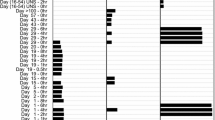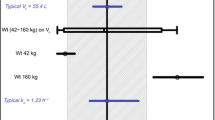Abstract
Objective
To develop a population pharmacokinetic/pharmacodynamic model describing the relationship between motesanib exposure and tumor response in a phase 2 study of motesanib in patients with advanced differentiated thyroid cancer or medullary thyroid cancer.
Methods
Data from patients (n = 184) who received motesanib 125 mg once daily were used for population pharmacokinetic/pharmacodynamic modeling. Motesanib concentrations were fitted to a 2-compartment population pharmacokinetic model. Observed change in tumor size was the drug response measure for the pharmacodynamic model. Exposure measures in the pharmacokinetic/pharmacodynamic model included dose, plasma concentration profile, or steady-state area under the concentration versus time curve (AUC ss ). A longitudinal exposure–tumor response model of drug effect on tumor growth dynamics was used.
Results
Motesanib oral clearance in patients with medullary thyroid cancer was 67% higher than in patients with differentiated thyroid cancer patients (73.7 vs. 44 L/h). Patients’ disease type (medullary thyroid cancer vs. differentiated thyroid cancer) was the most important covariate for explaining interpatient variability in clearance. The objective response rates were 14 versus 2% for differentiated thyroid cancer and medullary thyroid cancer, respectively. Motesanib exposure measures (AUC ss or concentration profile) were better predictors of tumor response than motesanib dose. The estimated motesanib concentration yielding tumor stasis (1.9 ng/mL) was lower than the observed trough concentrations in differentiated thyroid cancer and medullary thyroid cancer patients.
Conclusions
Differences in motesanib pharmacokinetics likely explain the difference in tumor response observed between differentiated thyroid cancer and medullary thyroid cancer patients. The population pharmacokinetic/pharmacodynamic model provides a tool for predicting tumor response to the drug to support the dosing regimen of motesanib in thyroid cancer patients.





Similar content being viewed by others
References
Karrison TG, Maitland ML, Stadler WM, Ratain MJ (2007) Design of phase II cancer trials using a continuous endpoint of change in tumor size: application to a study of sorafenib and erlotinib in non small-cell lung cancer. J Natl Cancer Inst 99:1455–1461
Lavin PT (1981) An alternative model for the evaluation of antitumor activity. Cancer Clin Trials 4:451–457
Claret L, Andre V, Alwis D, Bruno R (2008) Modeling and simulation to assess the use of change in tumor size as primary endpoint in phase II studies in oncology [abstract 1386]. Presented at: Annual Meeting of the Population Approach Group in Europe. Marseille, France, June 18–20
Wang Y, Sung C, Dartois C, Ramchandani R, Booth BP, Rock E, Gobburu J (2009) Elucidation of relationship between tumor size and survival in non-small-cell lung cancer patients can aid early decision making in clinical drug development. Clin Pharmacol Ther 86:167–174
Bruno R, Claret L (2009) On the use of change in tumor size to predict survival in clinical oncology studies: toward a new paradigm to design and evaluate phase II studies. Clin Pharmacol Ther 86:136–138
Claret L, Girard P, Hoff PM, Van Cutsem E, Zuideveld KP, Jorga K, Fagerberg J, Bruno R (2009) Model-based prediction of phase III overall survival in colorectal cancer on the basis of phase II tumor dynamics. J Clin Oncol 27:4103–4108
Rocchetti M, Simeoni M, Pesenti E, De Nicolao G, Poggesi I (2007) Predicting the active doses in humans from animal studies: a novel approach in oncology. Eur J Cancer 43:1862–1868
Simeoni M, Magni P, Cammia C, De Nicolao G, Croci V, Pesenti E, Germani M, Poggesi I, Rocchetti M (2004) Predictive pharmacokinetic-pharmacodynamic modeling of tumor growth kinetics in xenograft models after administration of anticancer agents. Cancer Res 64:1094–1101
Tham LS, Wang L, Soo RA, Lee SC, Lee HS, Yong WP, Goh BC, Holford NH (2008) A pharmacodynamic model for the time course of tumor shrinkage by gemcitabine + carboplatin in non-small cell lung cancer patients. Clin Cancer Res 14:4213–4218
Polverino A, Coxon A, Starnes C, Diaz Z, DeMelfi T, Wang L, Bready J, Estrada J, Cattley R, Kaufman S, Chen D, Gan Y, Kumar G, Meyer J, Neervannan S, Alva G, Talvenheimo J, Montestruque S, Tasker A, Patel V, Radinsky R, Kendall R (2006) AMG 706, an oral, multikinase inhibitor that selectively targets vascular endothelial growth factor, platelet-derived growth factor, and kit receptors, potently inhibits angiogenesis and induces regression in tumor xenografts. Cancer Res 66:8715–8721
Rosen LS, Kurzrock R, Mulay M, Van Vugt A, Purdom M, Ng C, Silverman J, Koutsoukos A, Sun YN, Bass MB, Xu RY, Polverino A, Wiezorek JS, Chang DD, Benjamin R, Herbst RS (2007) Safety, pharmacokinetics, and efficacy of AMG 706, an oral multikinase inhibitor, in patients with advanced solid tumors. J Clin Oncol 25:2369–2376
Sherman SI, Wirth LJ, Droz JP, Hofmann M, Bastholt L, Martins RG, Licitra L, Eschenberg MJ, Sun YN, Juan T, Stepan DE, Schlumberger MJ (2008) Motesanib diphosphate in progressive differentiated thyroid cancer. N Engl J Med 359:31–42
Schlumberger MJ, Elisei R, Bastholt L, Wirth LJ, Martins RG, Locati LD, Jarzab B, Pacini F, Daumerie C, Droz JP, Eschenberg MJ, Sun YN, Juan T, Stepan DE, Sherman SI (2009) Phase II study of safety and efficacy of motesanib in patients with progressive or symptomatic, advanced or metastatic medullary thyroid cancer. J Clin Oncol 27:3794–3801
Therasse P, Arbuck SG, Eisenhauer EA, Wanders J, Kaplan RS, Rubinstein L, Verweij J, Van Glabbeke M, van Oosterom AT, Christian MC, Gwyther SG (2000) New guidelines to evaluate the response to treatment in solid tumors European Organization for Research and Treatment of Cancer, National Cancer Institute of the United States, National Cancer Institute of Canada. J Natl Cancer Inst 92:205–216
Beal SL, Sheiner LB (1998) NONMEM user’s guide–part VII. Conditional estimation methods. NONMEM project group, University of California, San Francisco
Kebebew E, Clark OH (2000) Medullary thyroid cancer. Curr Treat Options Oncol 1:359–367
Li C, Kuchimanchi M, Hickman D, Poppe L, Hayashi M, Zhou Y, Subramanian R, Kumar G, Surapaneni S (2009) In vitro metabolism of the novel, highly selective oral angiogenesis inhibitor motesanib diphosphate in preclinical species and in humans. Drug Metab Dispos 37:1378–1394
Liddle C, Goodwin BJ, George J, Tapner M, Farrell GC (1998) Separate and interactive regulation of cytochrome P450 3A4 by triiodothyronine, dexamethasone, and growth hormone in cultured hepatocytes. J Clin Endocrinol Metab 83:2411–2416
Nishio N, Katsura T, Inui K (2008) Thyroid hormone regulates the expression and function of P-glycoprotein in Caco-2 cells. Pharm Res 25:1037–1042
Acknowledgments
The authors thank Peiming Ma, PhD, for his review and insightful comments as well as the study investigators, the clinical research support teams, and the patients who participated in the motesanib phase 2 thyroid cancer study. The authors also wish to thank Benjamin Scott, PhD (Complete Healthcare Communications, Inc., Chadds Ford, PA), and Emil Samara, PhD (PharmaPolaris, 30 Stanton Court, Danville, CA) whose work was funded by Amgen Inc., for editorial assistance in the preparation of this manuscript.
Conflict of interest
J-FL, LS, MK, RM, and Y-NS are employees of and stockholders in Amgen Inc. LC and RB are employees of Pharsight and contractors to Amgen Inc.
Author information
Authors and Affiliations
Corresponding author
Additional information
J.-F. Lu and L. Claret contributed equally to this manuscript.
Rights and permissions
About this article
Cite this article
Lu, JF., Claret, L., Sutjandra, L. et al. Population pharmacokinetic/pharmacodynamic modeling for the time course of tumor shrinkage by motesanib in thyroid cancer patients. Cancer Chemother Pharmacol 66, 1151–1158 (2010). https://doi.org/10.1007/s00280-010-1456-0
Received:
Accepted:
Published:
Issue Date:
DOI: https://doi.org/10.1007/s00280-010-1456-0




